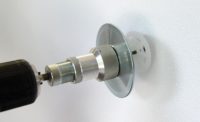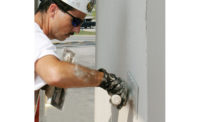Recycling Foam for CI Applications
Cash for Trash






It’s mind boggling when you discover how many new technologies have been introduced into our private lives from the NASA program, all in the spirit of solving problems they encounter as they explore planets in our solar system and beyond. These solutions now number in the thousands and, like an atom, they split and multiply into more improvements all the time and they just keep coming.
This happens in our world as well, albeit on a smaller scale. Take EIFS for example; we continue to see EIFS sprout its share of technological advances to improve our lives. Like NASA, EIF systems continue to produce ever-changing improvements for us to enjoy. We’re definitely using a lot less energy to heat and cool our buildings and the exterior coatings are able to withstand serious adverse weather conditions unlike anything we’ve seen in years past and they keep getting better.
Continuous Insulation
Continuous Insulation, the newest member of the building insulation family, has recently entered the scene and is promising to be another winner. But like NASA and EIFS, it will have to perform, and it will. Engineering will push new product solutions from hundreds of companies. So look for exciting new products that will offer solutions to whatever these great industries require.
One could point out that CI is the first step of EIFS and that the EIFS contractors and distributors should be poised to take the lead with the installation of CI, as they are indeed the experts in foam attachment. CI has created a new problem; foam waste. Not to worry, there is already a solution for this too; foam recycling. What could be better than turning a waste product into a revenue stream?
The much beloved Kermit the Frog says, “It’s not easy being green.” For many of us, this is how we used to look at recycling foam products and scraps. For many years we questioned if foam could even be recycled. Didn’t our favorite hamburger joint do away with those nifty foam boxes that kept those two all-beef patties warm because they would clog the landfills for years to come? Recently a mayor of one of the largest U.S. cities said he wanted to ban those foam takeout boxes because there is no way to recycle them.
Cardboard and paper can be baled and recycled. PET, water bottles, milk jugs, glass bottles and aluminum cans are all common recyclable products too. But what about foam? We have been told it never breaks down, ever. We have been programmed to think that foam will be in the landfill when our great-great-great grandchildren are born but this is no longer the case. Foam is not only recyclable, but it is also a great revenue source.
Types Of Foam
Let’s start by looking at some of the various types of foam: expanded polystyrene (EPS), polyiso, polyurethane, polyethylene (PE), polypropylene, rebond, cross-linked, latex, memory foam, open cell, closed cell, extruded polystyrene (XPS) and reticulated to name a few. Foam is used in over a hundred industries on thousands of products we use every day, including CI.
Some foam manufacturers will take back certain amounts of your scrap waste in cases where they can use the foam content mixed in with their virgin grade foam for products like Geofoam or carpet pads. Some enterprising companies are now using foam scraps for filler and memory foam pillows just to name a few more uses.
So what happens to the recycled foam? Recycled foam can be found in picture frames, clothes, shoes, pens, cell phone cases, interior and exterior trim beads and, are you ready for this, converted into oil that can then be processed into gas, diesel, kerosene and engine oil.
Recycling Foam
There are several ways to recycle foam. Grinding or shredding, compacting, baling and densifying are the most common. What is the best you ask? That depends on the foam type and what the desired final intent is. Do you want to reduce bulk to save floor space until you find someone to take the foam or would you like to turn your foam waste into money?
There are simple grinders that will reduce the bulk of a pile of foam like EPS to more manageable bags that are used as packaging peanuts. Some EPS and XPS ends up in potting soil as a hydrator. Geofoam, as mentioned earlier, is a great example of taking a negative and turning it into a positive. It is used in roadway construction, plaza decks and vegetative roofs. Now what can be better than that?
Shredders are great for tearing soft foams like PE which end up in items like pet beds and beanbags. We have one customer who used to pay tens of thousands of dollars a year to haul off dozens of dumpsters filled with foam a month. Now thanks to the implementation of densifiers, shredders and grinders at their facility, no foam is thrown away. All of their recycled foam ends up in products they sell into the market place.
Balers have a definite place in foam recycling. Some foams due to their chemical make-up, cannot be heated due to a release of sometimes harmful or toxic fumes. While others, due to their retention, need to be baled for transport. These foams often end up being mixed in with other foam and turned into what is known as rebond for automotive, motorcycle seats, padding, snowmobile seats, tractor seats, sports equipment and carpet pads.
Densifiers
Densifiers are the hottest trend and technology in foam recycling. Simply put, they grind down foam which drops into a heat chamber and is then melted into something that resembles the consistency of thick toothpaste. This drops into a brick shaped form that is easily stacked on a pallet. The reduction rate is an incredible 90:1. These densified bricks are money in the bank and are sold to brokers who then sell them to manufactures of picture and mirror frames, computer cases, tennis shoes and clothes. The densified foam bricks are used to make many of the ‘plastic’ items you come across in your day-to-day life.
There is much money to be made in the recycled foam business and many companies are cashing in on this booming industry. Entrepreneurs are operating densifiers, compactors, shredders, grinders and balers in areas that do not currently have recycling operations set up by their municipality or waste company.
Independent recyclers are now in the mix. We have a client who by day is a nurse; she saw the mounds of EPS packaging from medical products being thrown away, her concern for this led her to take action. She purchased a densifier and placed it in a shed; next to this shed is a fenced yard where people drop off their EPS from post-consumer purchases. The bricks she produces have paid for the machine and now she has a nice additional source of income.
Fabricators, manufacturers, warehouses and shippers of white goods (appliances, TV’s, furniture, etc.) have now realized that they too can save thousands of dollars a year and turn their foam waste into a source of revenue that before was treated as a source of aggravation.
So as we move forward with CI take comfort knowing the foam waste will be put to good use and may return to you some day as a coffee cup, the holder you place the cup in or even the plastic on your smart phone. Solutions always come out of problems. Have a problem? Keep looking and you will soon find the solution.
Looking for a reprint of this article?
From high-res PDFs to custom plaques, order your copy today!








